“Never to Forget” is the phrase often associated with Holocaust Remembrance. Books for the very young introduce this concept in broader terms whereas books for older readers offer more detailed accounts of people who witnessed, survived, or left a legacy of the experience behind. Teachers can find more information about resources, lesson plans, and ways of commemorating Holocaust Remembrance at the website for the United States Holocaust Memorial Museum.
Ages 4–8
Kopelman, Judy Tal. (2014). Grandpa’s Third Drawer: Unlocking Holocaust Memories. New York, NY: The Jewish Publication Society.
 Young Uri enjoys visiting his grandparents because they allow him to eat as many chocolates as he likes or he can linger at the breakfast table. One day, whileplaying at his grandfather’s desk he discovers a key. Exploring the desk, he finds it unlocks the third drawer. When he opens the drawer he finds objects strange to him. When Grandfather walks into the room, upset at seeing what Uri is doing, he calms himself and then begins to tell Uri the story behind the objects, actually artifacts, from the years of his childhood known as the Holocaust. Through photo-collage illustrations, Kopelman brings the story of the Jewish persecutions, worded for young children in a way that will open discussion for this difficult-to-explain era. A discussion guide is available at the University of Nebraska website. The original Hebrew edition won the Israeli Ze'ev Prize for Children's Literature in 2003 and won the first prize in Mits'ad Hasfarim (a nationwide survey of all schoolchildren in Israel for first to third grades) in 2003 and 2012. Grandpa's Third Drawer is now included in Israel's "Paths of Memory" nationwide Holocaust learning program in all schools.
Young Uri enjoys visiting his grandparents because they allow him to eat as many chocolates as he likes or he can linger at the breakfast table. One day, whileplaying at his grandfather’s desk he discovers a key. Exploring the desk, he finds it unlocks the third drawer. When he opens the drawer he finds objects strange to him. When Grandfather walks into the room, upset at seeing what Uri is doing, he calms himself and then begins to tell Uri the story behind the objects, actually artifacts, from the years of his childhood known as the Holocaust. Through photo-collage illustrations, Kopelman brings the story of the Jewish persecutions, worded for young children in a way that will open discussion for this difficult-to-explain era. A discussion guide is available at the University of Nebraska website. The original Hebrew edition won the Israeli Ze'ev Prize for Children's Literature in 2003 and won the first prize in Mits'ad Hasfarim (a nationwide survey of all schoolchildren in Israel for first to third grades) in 2003 and 2012. Grandpa's Third Drawer is now included in Israel's "Paths of Memory" nationwide Holocaust learning program in all schools.
Yolen, Jane. (2015). Stone Angel. Illus. by Katie May Green. New York, NY: Philomel/Imprint of Penguin Group.
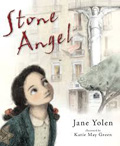 Set in Paris during World War II, an unnamed young girl narrates the story of her Jewish family’s escape when the Nazis arrive in France. First hiding in the woods and braving the cold and then dealing with the scarcity of food and the constant fear of being discovered by the Germans, the family flees over the mountains into Spain and then onto the seas in a boat setting sail for England to wait out the war. Green’s darkly colored mixed-media illustrations add to the imposing dangers at every turn. Perhaps a little too simplistically, the family finds happiness when they return to Paris to pick up the pieces of their lives and the young girl sees the angel statue outside their apartment and reflects on all the angels that guarded them during their war years away from home.
Set in Paris during World War II, an unnamed young girl narrates the story of her Jewish family’s escape when the Nazis arrive in France. First hiding in the woods and braving the cold and then dealing with the scarcity of food and the constant fear of being discovered by the Germans, the family flees over the mountains into Spain and then onto the seas in a boat setting sail for England to wait out the war. Green’s darkly colored mixed-media illustrations add to the imposing dangers at every turn. Perhaps a little too simplistically, the family finds happiness when they return to Paris to pick up the pieces of their lives and the young girl sees the angel statue outside their apartment and reflects on all the angels that guarded them during their war years away from home.
Ages 9–11
Hopkinson, Deborah. (2015). Courage & Defiance, Stories of Spies, Saboteurs, and Survivors in World War II Denmark. New York, NY: Scholastic . (Available August 2015)
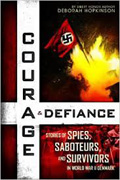 From Sibert Honor–winning author and noted writer of historical books for children, Deborah Hopkinson focuses her new book on the country of Denmark during World War II and their dramatically heroic efforts at saving the Jews in their country from the dictates of Hitler and his Nazi henchmen. The Danish resistance efforts rescued over 7,000 Jews during this period. Filled with archival photographs, the book is divided into five sections: Occupation and the Sparks of Defiance; Crackdown and Flight; Action and Arrest; Deported and Imprisoned; and Liberations. As the sections unfold in chronological order from the spies and saboteurs, the underground press, from individuals to organized resistance groups to collaborators and sympathizers, the stories of the Danish people and how they worked together as a community and as a nation to stand up for what was right at a time when this courage with little regard for their personal safety was not easy to accomplish.
From Sibert Honor–winning author and noted writer of historical books for children, Deborah Hopkinson focuses her new book on the country of Denmark during World War II and their dramatically heroic efforts at saving the Jews in their country from the dictates of Hitler and his Nazi henchmen. The Danish resistance efforts rescued over 7,000 Jews during this period. Filled with archival photographs, the book is divided into five sections: Occupation and the Sparks of Defiance; Crackdown and Flight; Action and Arrest; Deported and Imprisoned; and Liberations. As the sections unfold in chronological order from the spies and saboteurs, the underground press, from individuals to organized resistance groups to collaborators and sympathizers, the stories of the Danish people and how they worked together as a community and as a nation to stand up for what was right at a time when this courage with little regard for their personal safety was not easy to accomplish.
Lewis, J. Patrick. (2015). The Wren and the Sparrow. Illus. by Yevgenia Nayberg. New York, NY: Kar-Ben Publishing.
 Written in the style of a fable, the story is set in Poland during World War II. The location is actually the Łódź Ghetto where Polish Jews have been forced to live together. When the Tyrant (Hitler) calls for all musical instruments to be surrendered and turned over to the guards, the Wren, a local weaver and excellent musician, must bring his hurdy-gurdy into town to leave with the soldiers who are wearing swastika armbands on their sleeves. The Wren asks to play one more time and the townspeople band together and cry out and join the song as a last heroic act before the instruments and the Wren are dragged away, never to be seen again. However, Sparrow, a young girl who is a student of Wren’s, grabs the hurdy-gurdy that contains a secret message, and hides it away in a basement. Years later the hurdy-gurdy is discovered by a young boy and the message is revealed. Nayberg’s stylized and impressionistic illustrations add a somber beauty to the tale and colors brighten toward the end when the message of hope for the future is revealed.
Written in the style of a fable, the story is set in Poland during World War II. The location is actually the Łódź Ghetto where Polish Jews have been forced to live together. When the Tyrant (Hitler) calls for all musical instruments to be surrendered and turned over to the guards, the Wren, a local weaver and excellent musician, must bring his hurdy-gurdy into town to leave with the soldiers who are wearing swastika armbands on their sleeves. The Wren asks to play one more time and the townspeople band together and cry out and join the song as a last heroic act before the instruments and the Wren are dragged away, never to be seen again. However, Sparrow, a young girl who is a student of Wren’s, grabs the hurdy-gurdy that contains a secret message, and hides it away in a basement. Years later the hurdy-gurdy is discovered by a young boy and the message is revealed. Nayberg’s stylized and impressionistic illustrations add a somber beauty to the tale and colors brighten toward the end when the message of hope for the future is revealed.
Ages 12–14
Clark, Kathy. (2015). The Choice. New York, NY: Second Story.
 Based on the experiences of her father during the Holocaust of World War II and written in commemoration of the 70th anniversary of the liberation of Auschwitz, Kathy Clark continues her contributions in writing for the Holocaust Remembrance Books for Young Readers series. Set in Budapest, Hungary, young Jakob, newly renamed Hendrick, and his family have chosen to hide as Catholics rather than have their Jewish identity discovered. One day, Jakob has had enough witnessing the Jewish persecutions and defiantly announces his Jewish heritage and by doing this places his entire family in danger from the Nazis. When his best friend Ivan abandons Jakob and offers no help in allowing them to escape, Jakob is arrested and sent to Auschwitz. It is only his anger and drive for revenge against Ivan that keeps him alive within the concentration camp horrors. At the end of the war, Jakob returns to Budapest to seek out Ivan but learns that all kinds of difficult choices have to be made during wartime.
Based on the experiences of her father during the Holocaust of World War II and written in commemoration of the 70th anniversary of the liberation of Auschwitz, Kathy Clark continues her contributions in writing for the Holocaust Remembrance Books for Young Readers series. Set in Budapest, Hungary, young Jakob, newly renamed Hendrick, and his family have chosen to hide as Catholics rather than have their Jewish identity discovered. One day, Jakob has had enough witnessing the Jewish persecutions and defiantly announces his Jewish heritage and by doing this places his entire family in danger from the Nazis. When his best friend Ivan abandons Jakob and offers no help in allowing them to escape, Jakob is arrested and sent to Auschwitz. It is only his anger and drive for revenge against Ivan that keeps him alive within the concentration camp horrors. At the end of the war, Jakob returns to Budapest to seek out Ivan but learns that all kinds of difficult choices have to be made during wartime.
Cohen-Janca, Irène. (2015). Mister Doctor: Janusz Korczak & the Orphans of the Warsaw Ghetto. Translated by Paula Ayer. Illus. by Maurizio A.C. Quarello. Toronto, ON, Canada: Annick.
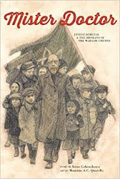 The remarkable true story of Dr. Janusz Korczak is told through text and stunningly somber illustrations. Mister Doctor, as he is known in 1940 by all the children in the orphanage at Krochmalna Street, Warsaw, Poland, has created revolutionary concepts in the care of orphan children. As the Nazis take over his city and force the children into the ghetto, Mister Doctor bravely leads the children to appease their fear. Two years later they are moved again, this time on their final journey as they are sent to Treblinka, a death camp. The Holocaust is difficult to explain to young children, and this book tells the story without graphic illustration and applauds a true hero of the period. It is the writing and actions of this brave man and his assistant Madam Stefa who were influential years later in the development of the United Nations Declaration on the Rights of the Child.
The remarkable true story of Dr. Janusz Korczak is told through text and stunningly somber illustrations. Mister Doctor, as he is known in 1940 by all the children in the orphanage at Krochmalna Street, Warsaw, Poland, has created revolutionary concepts in the care of orphan children. As the Nazis take over his city and force the children into the ghetto, Mister Doctor bravely leads the children to appease their fear. Two years later they are moved again, this time on their final journey as they are sent to Treblinka, a death camp. The Holocaust is difficult to explain to young children, and this book tells the story without graphic illustration and applauds a true hero of the period. It is the writing and actions of this brave man and his assistant Madam Stefa who were influential years later in the development of the United Nations Declaration on the Rights of the Child.
Gruenbaum, Michael with Todd Hasak-Lowy. (2015). Somewhere There Is Still a Sun: A Memoir of the Holocaust. New York, NY: Aladdin/Simon & Schuster.
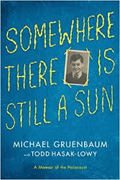 The author, a survivor of the Theresienstadt concentration camp located outside of Prague in then-Czechoslovakia, writes this memoir of his life in the camp. In 1942, Michael, along with his mother and sister, were sent to the camp and remained there until the end of the war. Narrated in the present tense by Misha, as Michael was called, he describes his very pleasant life with his family before the war in Prague. When the Nazis arrive and herd the Czech Jews into the ghetto, it is only a short time later they are deported to Theresienstadt, also known as Terezín. Misha was in a barracks with 40 boys. Some days were pleasant enough—filled with soccer and being with his new friends—but other times, they waited to hear the names on lists of people being sent to other camps, which often meant Auschwitz, a death camp. The story behind Michael’s family survival revolves around a secret and a teddy bear. Archival photos and primary documents add to the reality of this dark time.
The author, a survivor of the Theresienstadt concentration camp located outside of Prague in then-Czechoslovakia, writes this memoir of his life in the camp. In 1942, Michael, along with his mother and sister, were sent to the camp and remained there until the end of the war. Narrated in the present tense by Misha, as Michael was called, he describes his very pleasant life with his family before the war in Prague. When the Nazis arrive and herd the Czech Jews into the ghetto, it is only a short time later they are deported to Theresienstadt, also known as Terezín. Misha was in a barracks with 40 boys. Some days were pleasant enough—filled with soccer and being with his new friends—but other times, they waited to hear the names on lists of people being sent to other camps, which often meant Auschwitz, a death camp. The story behind Michael’s family survival revolves around a secret and a teddy bear. Archival photos and primary documents add to the reality of this dark time.
Peppas, Lynn Leslie. (2015). The Holocaust. New York, NY: Crabtree.
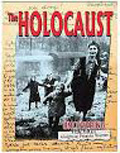 From the series, Uncovering the Past: Analyzing Primary Sources, this volume begins to answer questions that students, as well as adults, often ask: How did the Holocaust happen? How did Hitler accomplish this genocide? Beginning with the early 1900s, this book chronologically presents primary documents as evidence of the racism, discrimination, and nationalism that Germany and eventually Adolf Hitler used to manipulate everything to take control of Germany and put the country onto the path of genocide. This book and the series of which it is a part is asking readers to be critical thinkers as they look at the primary sources and evidence of Nazi propaganda and how it led people to misinterpret or create perspectives not necessarily their own. Examples of modern day situations direct readers to consider how history repeats itself.
From the series, Uncovering the Past: Analyzing Primary Sources, this volume begins to answer questions that students, as well as adults, often ask: How did the Holocaust happen? How did Hitler accomplish this genocide? Beginning with the early 1900s, this book chronologically presents primary documents as evidence of the racism, discrimination, and nationalism that Germany and eventually Adolf Hitler used to manipulate everything to take control of Germany and put the country onto the path of genocide. This book and the series of which it is a part is asking readers to be critical thinkers as they look at the primary sources and evidence of Nazi propaganda and how it led people to misinterpret or create perspectives not necessarily their own. Examples of modern day situations direct readers to consider how history repeats itself.
Ten Boom, Corrie. (2015). The Hiding Place: Young Reader’s Edition. Ada, MI: Chosen Books/Baker Publishing Group.
 The original book written by Corrie Ten Boom called The Hiding Place was published in 1971. Though not necessarily written for children, this book became one of the early books available on the Holocaust and has been used in classrooms across the country as an entry point to learn about the Holocaust for middle grade and high school readers. This new edition is specifically rewritten with younger readers in mind. The story remains that of the Ten Booms, a family celebrating the 100th anniversary of their watch-making and repair business in the Netherlands. This devoutly Christian family could not stand by and witness when the Nazis invaded their country and the brutal discriminatory treatment of the Jews began. The Ten Booms became active in the Dutch underground and were successful for a time in hiding Jews in the secret room in their home. Upon their discovery and arrest, they are sent to a concentration camp as collaborators. The heroism of this family is beyond compare, and their story is one that needs to be read, shared, and discussed.
The original book written by Corrie Ten Boom called The Hiding Place was published in 1971. Though not necessarily written for children, this book became one of the early books available on the Holocaust and has been used in classrooms across the country as an entry point to learn about the Holocaust for middle grade and high school readers. This new edition is specifically rewritten with younger readers in mind. The story remains that of the Ten Booms, a family celebrating the 100th anniversary of their watch-making and repair business in the Netherlands. This devoutly Christian family could not stand by and witness when the Nazis invaded their country and the brutal discriminatory treatment of the Jews began. The Ten Booms became active in the Dutch underground and were successful for a time in hiding Jews in the secret room in their home. Upon their discovery and arrest, they are sent to a concentration camp as collaborators. The heroism of this family is beyond compare, and their story is one that needs to be read, shared, and discussed.
Various authors. (2014). Remembering the Holocaust series. New York, NY: Enslow.
 Titles in this series include Anti-Semitism and the “Final Solution”; Auschwitz, Bergen-Belsen, Treblinka: The Holocaust Camps; Hitler, Goebbels, Himmler: The Nazi Holocaust Masterminds; Schindler, Wallenberg, Miep Gies: The Holocaust Heroes; Warsaw, Lodz, Vilna: The Holocaust Ghettos; Wiesel, Wiesenthal, Klarsfeld: The Holocaust Survivors. Each book in this series covers an aspect of the whole picture that led to the Jewish Holocaust of World War II. Use this as an introductory reference set for research projects on this topic. Archival photographs, a chronology, chapter notes, a glossary, further reading suggestions, and an index are helpful tools that will make this set a usable and student-friendly reference resource.
Titles in this series include Anti-Semitism and the “Final Solution”; Auschwitz, Bergen-Belsen, Treblinka: The Holocaust Camps; Hitler, Goebbels, Himmler: The Nazi Holocaust Masterminds; Schindler, Wallenberg, Miep Gies: The Holocaust Heroes; Warsaw, Lodz, Vilna: The Holocaust Ghettos; Wiesel, Wiesenthal, Klarsfeld: The Holocaust Survivors. Each book in this series covers an aspect of the whole picture that led to the Jewish Holocaust of World War II. Use this as an introductory reference set for research projects on this topic. Archival photographs, a chronology, chapter notes, a glossary, further reading suggestions, and an index are helpful tools that will make this set a usable and student-friendly reference resource.
Ages 15+
Deem, James M. (2015). The Prisoners of Breendonk: Personal Histories From a World War II Concentration Camp. Boston, MA: Houghton Mifflin Harcourt Books for Young Readers.
 Located outside Antwerp, Belgium, Breendonk was originally built as a fort in the early 1900s to prevent the Germans from entering Belgium. It was damaged during World War I and was not used much and so fell into disrepair. When the Nazis arrived during World War II, they brought the fort into the realm of a prison. Brutal beatings were common occurrences, and starvation was rampant. The inhuman treatment of these prisoners was horrifying. Though not really considered a concentration camp, called instead a “reception” camp, half of the numbered prisoners there survived only to be shipped on to Auschwitz for their final journey. The author has done in-depth research on this little-known camp and the photographs taken by Belgian photographer Leon Nolis bring a look at the camp today that recreates and haunts from the past in the old fortress. Visit the author’s website for more background information and photographs.
Located outside Antwerp, Belgium, Breendonk was originally built as a fort in the early 1900s to prevent the Germans from entering Belgium. It was damaged during World War I and was not used much and so fell into disrepair. When the Nazis arrived during World War II, they brought the fort into the realm of a prison. Brutal beatings were common occurrences, and starvation was rampant. The inhuman treatment of these prisoners was horrifying. Though not really considered a concentration camp, called instead a “reception” camp, half of the numbered prisoners there survived only to be shipped on to Auschwitz for their final journey. The author has done in-depth research on this little-known camp and the photographs taken by Belgian photographer Leon Nolis bring a look at the camp today that recreates and haunts from the past in the old fortress. Visit the author’s website for more background information and photographs.
Thor, Annika. (2015). Deep Sea. Translated from the Swedish by Linda Schenck. New York, NY: Delacorte/Random House.
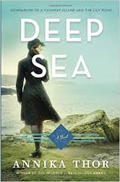 This story begins in the Mildred L. Batchelder Award–winning book, A Faraway Island (2009). It continues in the sequel, The Lily Pond (2011), a Mildred Batchelder Honor book. Deep Sea is the third book in a planned quartet of books about the Steiner sisters who have escaped to Sweden from Nazi-held Vienna, Austria. Their parents are still imprisoned there, but the girls soon learn they have been transported to Theresienstadt. The story opens four years after the last book when the sisters are separated. Older sister Stephie is living in Göteborg with friends and has hopes to continue her education to become a doctor, though funding is problematic. As Stephie meets other Jewish refugees, she rediscovers her own Jewish identity and learns to be proud of this, but not so much for younger sister Nellie. Religious issues, genocide, teen pregnancy and other issues all set with the overarching dark cloud of the Holocaust makes this a book for older readers.
This story begins in the Mildred L. Batchelder Award–winning book, A Faraway Island (2009). It continues in the sequel, The Lily Pond (2011), a Mildred Batchelder Honor book. Deep Sea is the third book in a planned quartet of books about the Steiner sisters who have escaped to Sweden from Nazi-held Vienna, Austria. Their parents are still imprisoned there, but the girls soon learn they have been transported to Theresienstadt. The story opens four years after the last book when the sisters are separated. Older sister Stephie is living in Göteborg with friends and has hopes to continue her education to become a doctor, though funding is problematic. As Stephie meets other Jewish refugees, she rediscovers her own Jewish identity and learns to be proud of this, but not so much for younger sister Nellie. Religious issues, genocide, teen pregnancy and other issues all set with the overarching dark cloud of the Holocaust makes this a book for older readers.
Various authors. (2015). A Documentary History of the Holocaust series. New York, NY: Rosen.
 A reference collection of books that can be used for research or for students interested in various aspects of the Holocaust, this student-friendly series features the historical, political, and social background to begin an in-depth look into this dark period of the 20th century. Documentary evidence and survivor testimonies are included, in addition to numerous features such as sidebars, timelines, glossary, further information, organizations, further reading, websites, bibliography, index, and author biography. The titles in this series include Elie Wiesel, Jewish Resistance Against the Holocaust, Kristallnacht and Living in Nazi Germany, Nazi Architects of the Holocaust, Nazi Concentration Camps, Righteous Gentiles, The Nuremberg Trials, The Warsaw Ghetto and Uprising.
A reference collection of books that can be used for research or for students interested in various aspects of the Holocaust, this student-friendly series features the historical, political, and social background to begin an in-depth look into this dark period of the 20th century. Documentary evidence and survivor testimonies are included, in addition to numerous features such as sidebars, timelines, glossary, further information, organizations, further reading, websites, bibliography, index, and author biography. The titles in this series include Elie Wiesel, Jewish Resistance Against the Holocaust, Kristallnacht and Living in Nazi Germany, Nazi Architects of the Holocaust, Nazi Concentration Camps, Righteous Gentiles, The Nuremberg Trials, The Warsaw Ghetto and Uprising.
Karen Hildebrand is retired library media specialist and Library Director for Delaware City Schools in Delaware, OH. She is currently an adjunct professor at Ashland University in Ohio, a reading consultant, and a Holocaust Fellow at the United States Holocaust Memorial Museum in Washington, DC, and chairs the Education Curriculum Committee for the Delaware County Historical Society.
The review contributions are provided by members of the International Literacy Association’s Children’s Literature and Reading Special Interest Group.